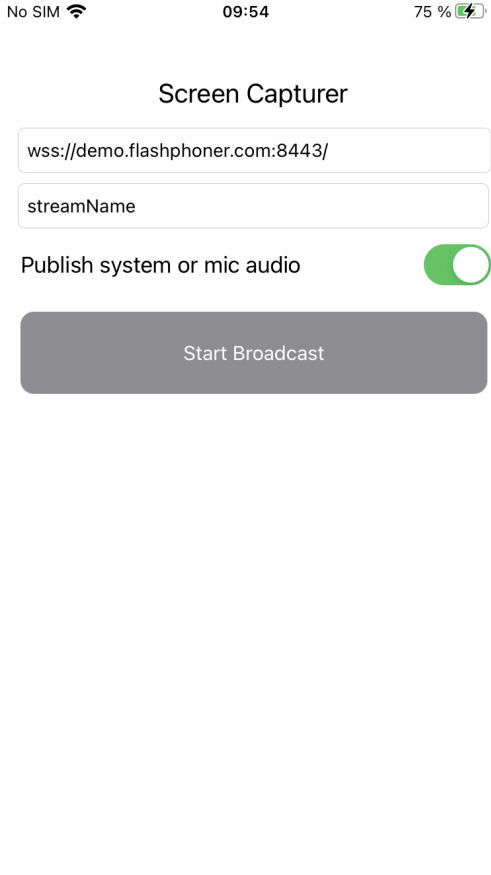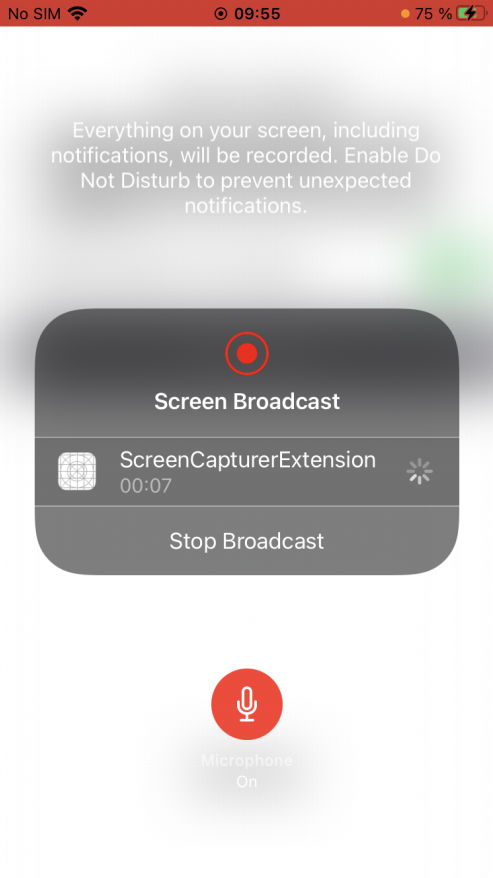iOS Screen Capturer Swift¶
iOS application example to capture stream from device screen¶
This example can be used to publish WebRTC stream from device screen with system audio or microphone audio capturing. The example works with iOS SDK 2.6.82 and newer.
The main application view is shown below. Inputs:
- WCS Websocket URL
- screen video stream name to publish

Application view when screen sharing is started

A special extension process is used to capture video from screen. This pocess works until device is locked or screen cpturing is stopped manually.
Analyzing the example code¶
To analyze the code take ScreenCapturer example version which is available on GitHub.
Classes
- main application view class:
ScreenCapturerViewController(implementation file ScreenCapturerViewController.swift) - extension implementation class:
ScreenCapturerExtensionHandler(implementation file ScreenCapturerExtensionHandler.swift)
1. Import API¶
2. Screen capturer extension parameters setup¶
UserDefaults.suiteName parameter must be equal to extension application group id
@IBAction func broadcastBtnPressed(_ sender: Any) {
...
pickerView.showsMicrophoneButton = systemOrMicSwitch.isOn
let userDefaults = UserDefaults.init(suiteName: "group.com.flashphoner.ScreenCapturerSwift")
userDefaults?.set(urlField.text, forKey: "wcsUrl")
userDefaults?.set(publishVideoName.text, forKey: "streamName")
userDefaults?.set(systemOrMicSwitch.isOn, forKey: "useMic")
...
}
3. Receiving screen capture parameters in extension code¶
override func broadcastStarted(withSetupInfo setupInfo: [String : NSObject]?) {
...
let userDefaults = UserDefaults.init(suiteName: "group.com.flashphoner.ScreenCapturerSwift")
let wcsUrl = userDefaults?.string(forKey: "wcsUrl")
if wcsUrl != self.wcsUrl || session?.getStatus() != .fpwcsSessionStatusEstablished {
session?.disconnect()
session = nil
}
self.wcsUrl = wcsUrl ?? self.wcsUrl
let streamName = userDefaults?.string(forKey: "streamName")
self.streamName = streamName ?? self.streamName
...
}
4. Screen capturer object setup to capture audio¶
FPWCSApi2.getAudioManager().useAudioModule code
let useMic = userDefaults?.bool(forKey: "useMic")
capturer = ScreenRTCVideoCapturer(useMic: useMic ?? true)
FPWCSApi2.getAudioManager().useAudioModule(true)
5. Session creation to publish screen stream¶
WCSSession, WCSSession.connect code
if (session == nil) {
let options = FPWCSApi2SessionOptions()
options.urlServer = self.wcsUrl
options.appKey = "defaultApp"
do {
try session = WCSSession(options)
} catch {
print(error)
}
...
session?.connect()
}
6. Screen stream publishing¶
WCSSession.createStream, WCSStream.publish code
The following parameters are passed to createStream method:
- stream name to publish
ScreenRTCVideoCapturerobject to capture video from screen
func onConnected(_ session:WCSSession) throws {
let options = FPWCSApi2StreamOptions()
options.name = streamName
options.constraints = FPWCSApi2MediaConstraints(audio: false, videoCapturer: capturer);
try publishStream = session.createStream(options)
...
try publishStream?.publish()
}
7. ScreenRTCVideoCapturer class initialization¶
fileprivate class ScreenRTCVideoCapturer: RTCVideoCapturer {
let kNanosecondsPerSecond = 1000000000
var useMic: Bool = true;
init(useMic: Bool) {
super.init()
self.useMic = useMic
}
...
}
8. System audio capturing in extension code¶
FPWCSApi2.getAudioManager().getAudioModule().deliverRecordedData() code
func processSampleBuffer(_ sampleBuffer: CMSampleBuffer, with sampleBufferType: RPSampleBufferType) {
switch sampleBufferType {
...
case RPSampleBufferType.audioApp:
if (!useMic) {
FPWCSApi2.getAudioManager().getAudioModule().deliverRecordedData(sampleBuffer)
}
break
...
}
}
9. Microphone audio capturing in extension code¶
FPWCSApi2.getAudioManager().getAudioModule().deliverRecordedData() code
func processSampleBuffer(_ sampleBuffer: CMSampleBuffer, with sampleBufferType: RPSampleBufferType) {
switch sampleBufferType {
...
case RPSampleBufferType.audioMic:
if (useMic) {
FPWCSApi2.getAudioManager().getAudioModule().deliverRecordedData(sampleBuffer)
}
break
...
}
}
Known limits¶
-
Music from iTunes will not play when system audio capturing is active.
-
ScreenCapturerSwiftextension will receive a silence insampleBufferboth from microphone and system audio if some other application uses the microphone. When microphone is released by other application, it is necessary to stop screen publishing and start it again to receive any audio.